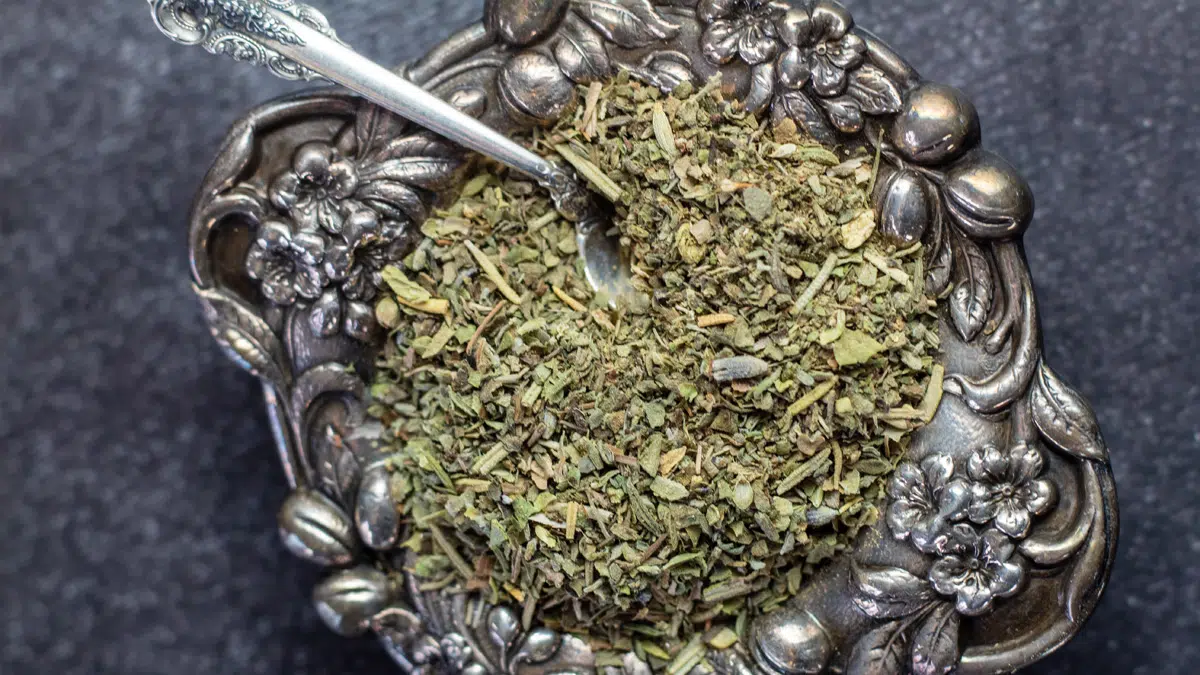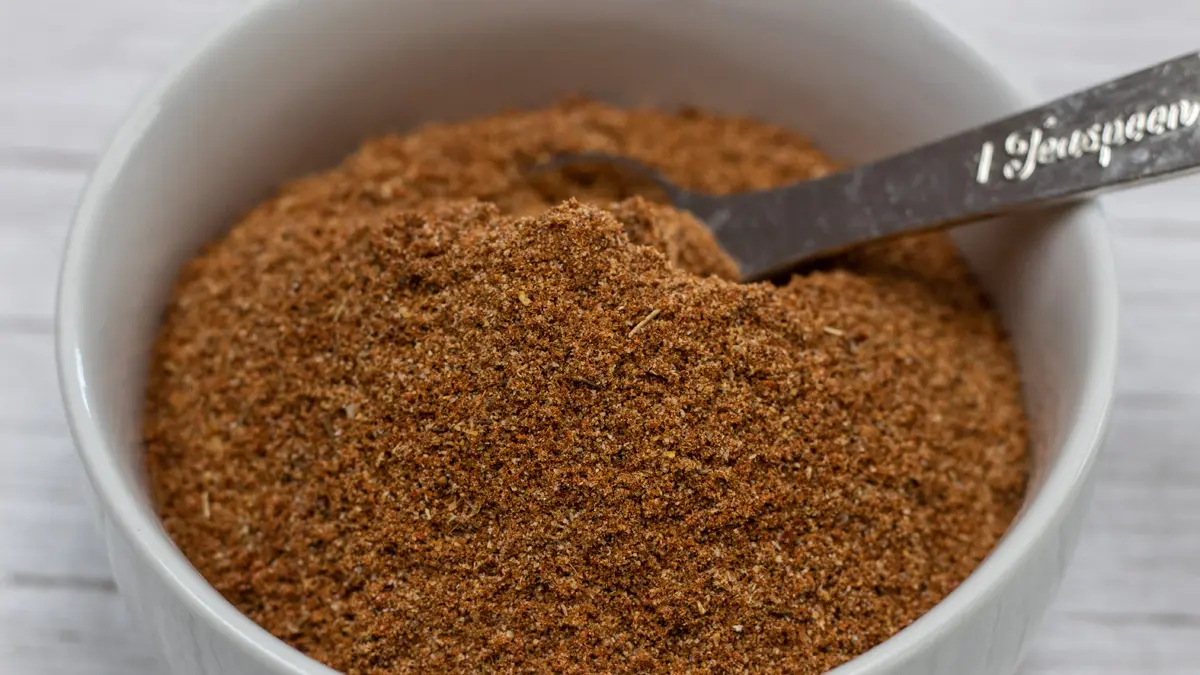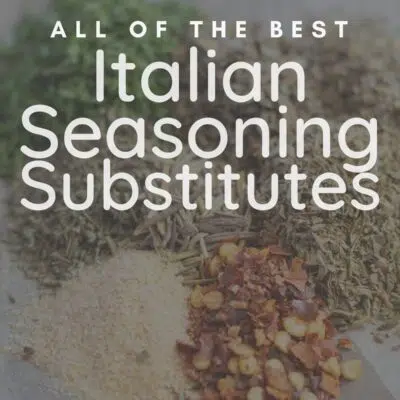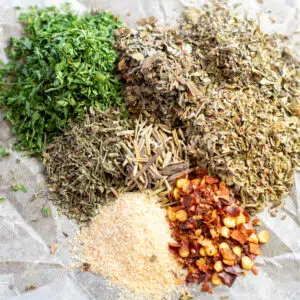You never know when a good Italian seasoning substitute could come in handy because it's an integral part of so many recipes! Italian seasoning is one of the most popular seasoning blends, and as such, you may come across it in a recipe and realize you're out! No need to panic, any of the simple Italian seasoning substitutions on this list can help you out in a pinch.
Italian Seasoning Substitutes
When it comes to favorite foods, Italian dishes are among some of the most popular. With a variety of rich and savory flavors, it is easy to see why.
One of the most familiar flavors comes from a blend of herbs. This special blend of herbs is a standard seasoning that is used to enhance the flavor of spaghetti sauce, meatballs, chicken, and many other dishes.

Jump to:
- Italian Seasoning Substitutes
- The Best Substitute for Italian Seasoning
- 1. Homemade Italian Seasoning
- Herb Substitutes
- 2. Basil + Oregano
- 3. Basil
- 4. Oregano
- 5. Thyme
- 6. Sage
- 7. Marjoram
- 8. Rosemary
- 9. Parsley
- Spice Blend Substitutes
- 10. Herbes De Provence
- 11. Greek Seasoning
- 12. Pizza seasoning
- 13. Za'Atar
- 14. Cajun
- 15. Fresh Herbs
- How To Substitute Fresh Herbs For Italian Seasoning
- 📖 Recipe Card
- 💬 Comments & Reviews
Italian seasoning blends can vary, depending on who makes them. However, there are a few standard herbs used in all of them: oregano, basil, marjoram, thyme, rosemary, parsley, and sage. In addition, some blends will add in garlic powder, red chili flakes, and maybe even fennel.
The Best Substitute for Italian Seasoning
The great thing about Italian Seasoning is that it is super easy to make at home! If you have all of the right herbs, you just measure & mix. Here are the measurements for my favorite homemade Italian Seasoning.
1. Homemade Italian Seasoning
- 2 tablespoons Basil
- 1 teaspoon Marjoram
- 2 tablespoons Oregano
- 1 teaspoon Garlic Powder
- 1 tablespoon Rosemary
- 2 tablespoons Parsley
- 1 tablespoon Thyme
- 1 tablespoon Red Chili Flakes
If you have all these ingredients on hand, head on over to my full Italian seasoning recipe for directions on how to mix and store your Homemade Italian Seasoning.
If you only have a few of these ingredients, you may still have a great substitute! Keep reading to see how each of these herbs can be used individually to enhance the flavor of your dish.
In the case that you don't have any of these spices on hand, not to worry! You may have another great substitute hiding in your cupboard. Check out the other spice blends that can be used to replace Italian seasoning.
Herb Substitutes
2. Basil + Oregano
Okay, this one is two herbs but together they make a quick and easy substitute for Italian seasoning. Since basil and oregano are the two primary ingredients in Italian Seasoning, they provide the closest flavor substitute. They are also two of the most common spices to have at home.
If you don't have all the spices needed to make your own Italian seasoning you can make this simplified version. Mix basil and oregano in a 2:1 ratio: 2 teaspoons of basil and 1 teaspoon of oregano to replace 1 tablespoon of Italian Seasoning.
3. Basil
You can also use basil on its own. It won't add the complexity of combing it with oregano, but it will still lend an Italian taste. On its own, basil will lend an earthy and sweet taste.
Too much of one spice can be overpowering. Therefore, use half the amount the recipe calls for in Italian Seasoning.
4. Oregano
The distinct earthy aroma and flavor of oregano are what many first associates with Italian cuisine. This flavorful herb is quite strong on its own. Therefore, use a small amount on its own.
Use ½ the amount of oregano. You can always add more if needed or combine it with any of these other herbs you have on hand.
5. Thyme
Thyme is another great herb that reflects the traditional flavors of Italian Cooking. It is a varietal of mint, just like oregano.
Even though thyme is milder than oregano, still use only ½ the amount to begin with.
6. Sage
Dried sage has a distinct flavor that is quite strong. Its flavor pairs exceptionally well with other herbs like oregano and thyme. However, on its own, it can quickly overpower other flavors in a recipe.
Use sage in small amounts when using it alone. Start with a ¼ amount and try to blend with one or two other spices.
7. Marjoram
Marjoram is a member of the mint family alongside oregano and thyme. It offers a similar earthy flavor that has hints of mint. Compared to the other two herbs, it is a bit sweeter. It is also milder than oregano.
Use ½ the amount of marjoram to begin with.
8. Rosemary
Even though rosemary is often included in Italian Seasoning it is not a dominant flavor. It is used to help blend and elevate the other primary flavors. Therefore, you will notice a flavor change when using rosemary on its own.
Start with a ¼ of rosemary and taste your dish. If desired, slowly add more. You can also combine rosemary with other seasonings to get a more complex flavor.
9. Parsley
Compared to the other herbs, parsley has a milder flavor. Therefore, it is a good choice to use on its own if you don't want a lot of flavor added to your recipe.
Spice Blend Substitutes
Beyond Italian Seasoning, several spice blends accompany different types of food around the world. While each of these blends has its own unique taste, many of them share a similar flavor base.
10. Herbes De Provence
Herbes De Provence is native to French cooking. Its base is made up of the same seasonings used to make Italian seasoning. However, in addition to the oregano and other herbs, it also has lavender. It may also include tarragon and fennel.
The addition of lavender, tarragon, and fennel changes creates a completely new flavor profile. Therefore, be mindful of what foods you are pairing it with. Traditionally, it pairs well with chicken, eggs, and root vegetables.
If you think Herbes De Provence will pair well with the ingredients in your dish, try it out! It is a lovely spice blend to elevate the flavor. To avoid overpowering your primary flavors with a new flavor, start with half the amount.

11. Greek Seasoning
Greek seasoning is another spice blend that shares qualities with Italian Seasoning. It has a strong base of oregano, basil, parsley, and garlic powder that resembles Italian flavors. In addition, it often includes dill, onion powder, and black pepper.
Like Herbes De Provence, the addition of new flavors will shift the original flavor of your recipe. In this case, the primary new flavor is dill. Even in small amounts, dill has a strong presence when used.
Therefore, consider if dill will complement the other ingredients. Moreover, consider if those you are cooking for will enjoy the flavor of dill.
Despite the addition of other flavors, Greek Seasoning can be used in a 1:1 exchange for Italian Seasoning.
12. Pizza seasoning
Pizza seasoning sounds like it is the same thing as Italian seasoning, but there are some differences. While it starts with the same base as Italian seasoning it usually includes the addition of garlic powder, onion powder, and fennel.
While these three additional spices are not in Italian Seasoning, they are common in Italian cooking. Therefore, you can easily add Pizza Seasoning to most dishes that call for Italian Seasoning.
Use Pizza Seasoning in a 1:1 substitution for Italian Seasoning in most dishes.
13. Za'Atar
If you cook a lot of Middle Eastern cuisine, then you may Za'Atar in your spice cabinet. Like the other seasonings from around the world, Za'Atar has a base of oregano. It also includes thyme.
The unique addition to Za'Atar is sesame seeds! This simple and unique blend is extremely versatile. It is used as a seasoning for lamb and even has been said to be great on popcorn!
Za'Atar can be used in a 1:1 substitution for Italian Seasoning in many recipes. If you are not sure how it will shift the flavor of your recipe, start with half and add more if desired (or needed).
14. Cajun
Of all the spice blends, this one is the least like Italian Seasoning! However, the rich flavors found in Cajun seasoning are a wonderful addition to many dishes!
If you want to shift the overall flavor profile of your recipe from the earthy tones of Italian Seasoning to a smoky flavor with a kick- try Cajun Seasoning.
Since Cajun Seasoning is a completely new flavor profile, start with a small amount. You may end up using a full 1:1 ratio, but it is best to add it slowly until you find the perfect new taste.

15. Fresh Herbs
While Italian Seasoning is traditionally a dried spice blend, if you have fresh herbs on hand, they will get the job done! If using fresh herbs, choose herbs that would traditionally be found in Italian Seasoning:
- Basil
- Oregano
- Parsley
- Thyme
- Rosemary
- Marjoram
Dried herbs are more concentrated in flavor than fresh herbs. Therefore, you will need to use more to get the right flavor. The exact ratio will be different depending on the fresh herbs you have on hand.
How To Substitute Fresh Herbs For Italian Seasoning
If you have all the herbs listed above, use the ratios provided earlier for making your own homemade Italian Seasoning. Triple the ratio of each dried herb to get the full flavor from the fresh herbs.
More than likely, you may only have one fresh herb available. You will still need to use a 3:1 ratio of fresh herb for dried herb. Make sure you only do a 3:1 ratio for what the dried herb substitute would be though. Just like with the single dried herbs, you don't want to overpower the recipe with too much of one flavor.
Use the ratios from the single dried herbs listed above as a guide on how much to use as a substitute.
If you found this article on finding an Italian seasoning substitute useful, please let us know in the comments below! We wish you the best in all your cooking and baking endeavors!
Do you love a recipe you tried? Please leave a 5-star 🌟rating in the recipe card below and/or a review in the comments section further down the page.
Stay in touch with me through social media @ Pinterest, Facebook, Instagram, or Twitter! Subscribe to the newsletter today (no spam, I promise)! Don't forget to tag me when you try one of my recipes!
📖 Recipe Card
Best Italian Seasoning Substitute: Homemade Italian Seasoning Blend (+More Great Alternatives!)
Ingredients
- 1 tablespoon Italian seasoning (use my homemade blend)
- 1 tablespoon basil + oregano
- ½ tablespoon basil
- ½ tablespoon oregano
(Note: 2x or 3x only changes the ingredient list)
Instructions
- Use either my homemade Italian seasoning or a blend of 2 teaspoons dried basil + 1 teaspoon dried oregano in a 1:1 ratio to substitute for any Italian seasoning called for in a recipe.
- Alternatively, you can use half the amount of either dried basil or dried oregano to substitute for Italian seasoning.



Comments
No Comments